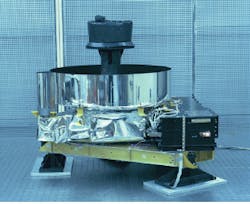Mars Surveyor altimeter flies high in orbital test
After a 10-month journey through interplanetary space, the Mars Global Surveyor (MGS) has settled into its initial orbit about the Red Planet. Designed to perform a two-year study of Mars, the MGS carries an array of scientific instruments that includes a visible-wavelength camera, a thermal-emission spectrometer, an electron reflectometer, an atmospheric experiment, and a magnetometer that has already discovered the presence of a planetary magnetic field.
The payload also includes the Mars Orbiter Laser Altimeter (MOLA), a laser rangefinder that will map the surface topography of the planet (see photo). During the initial elliptical orbit about the planet, scientists and engineers at NASA Goddard Space Flight Center (Greenbelt, MD) initialized instrument operations and successfully ranged to the Martian surface.
The MOLA is a heterodyne laser radar system that uses time-of-flight detection to determine the distance to the planet surface. A transmitter sends a laser pulse to the planet surface, and the system registers the elapsed time to detection of the backscattered return pulse. These data can be converted to a distance measurement that will provide topographical data about the surface.
The transmitter is a diode-pumped, Q-switched chromium and neodymium codoped YAG (Cr,Nd:YAG) slab laser operating at 1064 nm. The laser fires 45-mJ, 8-ns pulses to the planetary surface at a 10-Hz repetition rate. The transmitter produces a 0.4-mrad spot that spreads to a diameter of 130 m on the planet surface.
During ranging operations, a beamsplitter diverts a portion of the output pulse to the system detector, which starts the time-of-flight counter. A telescope with a 50-cm parabolic mirror collects the signal backscattered from the planet surface and launches it into a single-mode optical fiber that relays the signal to a silicon avalanche photodiode detector (APD). The APD produces a voltage in proportion to the number of photons detected. When the voltage exceeds a noise threshold, the detector generates a signal that stops the time-of-flight counter. The instrument achieves a shot-to-shot vertical precision of 40 cm, with an absolute accuracy of 10 m, the latter limited by knowledge of the spacecraft orbit.
System test
During the spacecraft’s third orbit of the planet, the MOLA team operated the instrument at distances between 260 and 800 km from the Martian surface. "The whole point of the pass was to make sure that the laser was operating properly and to verify that the signal response from the surface was as estimated so that the instrument thresholds were set properly," says principal investigator David Smith of NASA Goddard Space Flight Center. "On all accounts it appeared to perform flawlessly."
The instrument achieved a 99.8% detection rate—out of the roughly 12,600 pulses transmitted during the 21-minute test, the team detected noise returns on just 18. Although most of the false returns are probably caused by instrument electronics, some may represent backscattering from the Martian atmosphere. "We should be sensitive to certain kinds of clouds," Smith says. "Two to three of the returns appear to be from within 5 to 6 km of the surface."
Far from being a detriment, such atmospheric returns may be serendipitous. "It won’t affect the topographical mapping," he notes. "Occasionally we`ll get a measurement from the atmosphere that will tell us something about the level of the planetary boundary layer or clouds. It`s actually an additional bonus—these are the questions that the atmospheric scientists ask."
The instrument will begin mapping the surface on March 15, 1998, after the spacecraft completes aerobraking to a circular orbit approximately 400 km from the surface, with 93° inclination. The mapping process will take about 22 months. "It will help us understand the shape of the planet and the forms of geological features on the surface," Smith says. "We’ll begin to understand the formation of the planet and its structure."
Already the data from the test run has produced some interesting information. Preliminary reviews show the expected craters, channels, and faulted structures, but views of the northern hemisphere reveal it to be much flatter than anticipated. The discoveries will continue over the course of the two-year project, allowing planetary scientists to achieve a better understanding of the planet most like Earth.
About the Author
Kristin Lewotsky
Associate Editor (1994-1997)
Kristin Lewotsky was an associate editor for Laser Focus World from December 1994 through November 1997.
